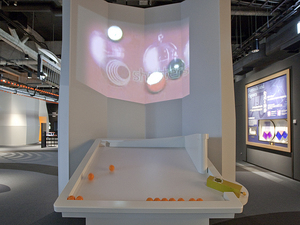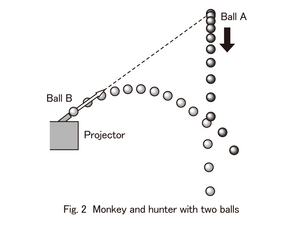Nagoya City Science Museum
TOP > Exhibition Guide > Keyword Search > Starting with "M" > motion > The Monkey And The Hunter
The Monkey And The Hunter



Purpose of Exhibition
We will get you to understand a law hidden in the motion of an object, through an experiment in which a falling ball is aimed at and hit by a ball shot from below.
Additional Knowledge
Suppose that you are aiming a gun at a monkey hanging on the branch of a tree. At the moment after the trigger is pulled, if the monkey realizes it and lets go of the branch and falls, would the bullet still hit the monkey or miss it? This is the focal point of this experiment: the monkey and the hunter. Two balls are used to carry out this experiment in this exhibition. A ball is set on the upper side of a slope and the other one is placed below to aim at the upper ball from a diagonal position. There is a structure in which the ball on the upper side of the slope starts rolling down right after the ball set below is shot at the ball on the slope. As a result of the experiment, the ball shot from below can hit the ball rolling down from the slope. Even if changing the shooting speeds of the ball shot from below, although the hitting positions can vary, it always hits the falling ball successfully. This kind of experiment is related to dynamics in physics. Dynamics deal with motion of an object. The purpose of this exhibition is to inform a universal law hidden in the motion of an object (a ball) falling straight down and an object (a ball) shot in a diagonal position.
In this exhibition, three important points are abridged as follows:
- Two balls start moving simultaneously- A ball below is shot straight at a ball on the upper side of the slope.
- No matter how fast the ball below is shot, the two balls never fail to hit each other.
Firstly, take into consideration what happens if this experiment is carried out in a place with no gravity. A ball set on the upper side of the slope will never be pushed to fall; once the experiment has started, it remains at the same position as it is. Since there is no gravity, it never falls. The ball set below will be shot to aim at the ball placed on the slope. It will fly straight to the ball and will hit the static ball.
Now, take into consideration how balls move with gravity. A ball situated on the slope falls, drawn by gravity. Although the ball below is shot diagonally, it is also attracted to gravity. It cannot fly straight. As anybody can experience, when throwing a ball, it falls like an arc. Gravity is applied equally with the balls on top of the slope and below. In short, the falling distance of the balls above and below is the same. But, the ball above just falls (free falling). The one below is shot up and gradually falls (it is called to draw a parabola). Therefore, their falling distances do not look the same. However, if gravity were not applied, the falling distance of two balls thrown from the level with gravity would be the same. Take the ball below for example. If there is no gravity, it should be able to reach the same level where the ball above is situated. But, it reaches lower due to gravity. At this point, the distance fallen by gravity is the equivalent to that of the ball on the slope above, which falls due to free falling. Without gravity, the two balls would have met at the level at which they were supposed to hit each other, where the ball above was first situated. But, with gravity, these two encounter at the point where the ball above freefalls. This is the reason why balls never fail to hit each other in this experiment. As stated above, the motion of an object can be calculated through the force which is applied to that object. A probe launched with the rocket can reach the astronomical objects it is aiming for by calculating primarily engine output power and gravity applied from the sun and planets.
Article by Yoshitaka Yamada, curator
